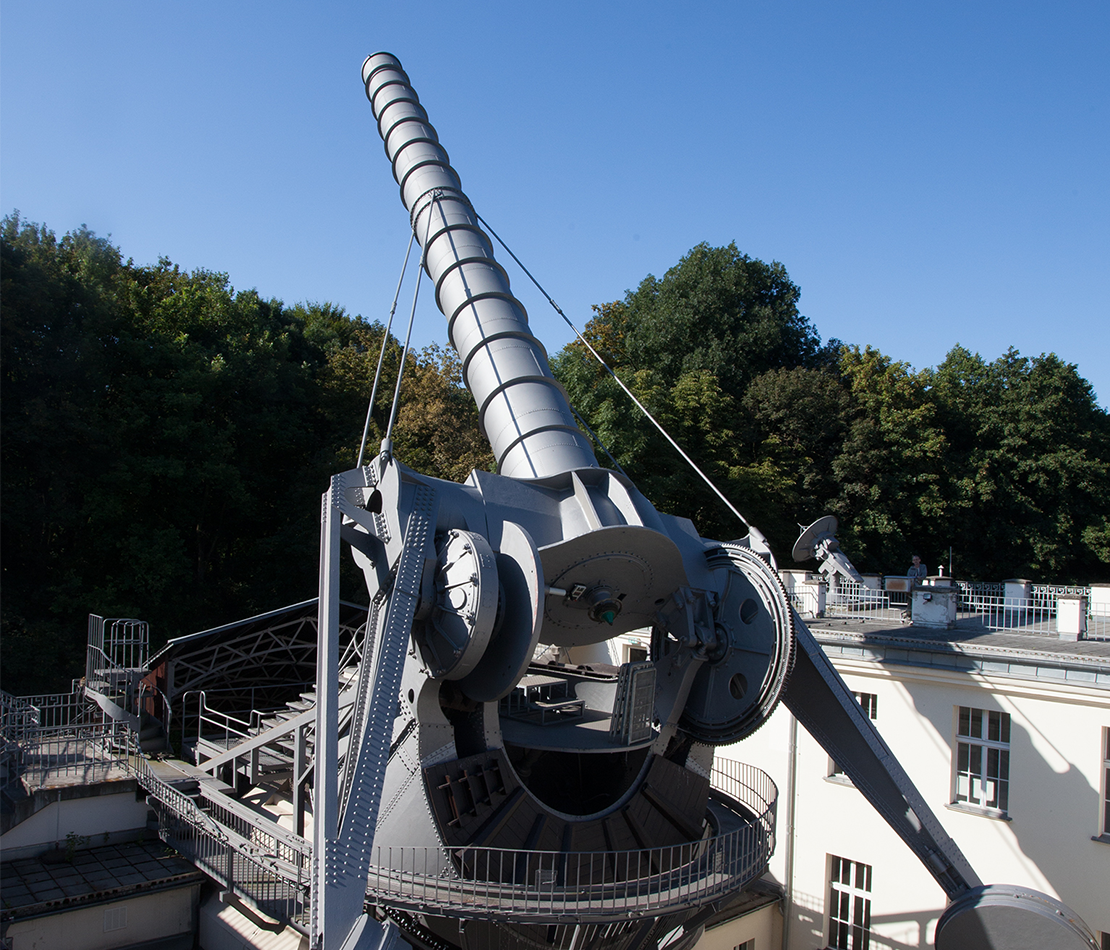
Technology and Instruments
Archenhold-Sternwarte
Giant Telescope
The heart of the Archenhold-Sternwarte is the Treptow Giant Telescope. Originally, only an exhibit of the Treptow Industry and Trade Exhibition in 1896, the device remained in Treptow Park after the end of the exhibition and became the nucleus of today's observatory. The creator of the telescope and founder of the observatory was the astronomer Friedrich Simon Archenhold (1861 - 1939). With a focal length of 21 metres, the instrument is the longest fully movable refractor in the world and is still used today. It is mainly used for public observations during the winter months. Its unique construction served as a model for the Zeiss relief mount for large telescopes, which was developed from 1900 onwards. The instrument's optics make it ideal for observing planets, the moon and binary stars.
Optical data: Steinheil lens, d = 680 mm (taken down to 580 mm because of damage), f = 21,000 mm; mount F. Meyer/C. Hoppe, Berlin

500 mm reflecting telescope

The 500 mm reflecting telescope was installed on the observatory grounds in the early 1960s. It was intended to replace the Giant Telescope, which was temporarily shut down at that time.
This telescope is particularly suitable for observing so-called deep sky objects – stars, nebulae and galaxies, but planets or the moon can also be observed very well with it. The possible magnifications are between approx. 120x and 470x. The 500 mm reflector is a Cassegrain telescope, which means that the viewer can observe comfortably from behind it. It is the instrument most often used by visitors and amateurs.
Optical data: Zeiss primary mirror, d = 500 mm, f = 7,500 mm; mount and dome: Zeiss/Jena
Other instruments
150 mm Coudé refractor
The 150 mm Coudé refractor is located under a 3-metre dome in the outdoor area. Its beam path is deflected into the hour axis of the mount with two mirrors. This makes the instrument very compact and ensures comfortable viewing. The optically outstanding telescope is mainly used by working groups and amateur astronomers for solar and planetary observations.
Optical data: Zeiss AF lens, d = 150 mm, f = 2,250 mm; mount and dome: Zeiss/Jena
Radio telescope
A radio telescope is also mounted on the roof of the observatory. Its 1,880-mm parabolic antenna is designed to receive 2.6-cm radiation from the sun (11.6 GHz). It can be used to observe radio radiation down to the lowest chromospheric layer of the sun. The radio telescope is mainly used for demonstration purposes.
Astrograph
Also on the roof of the main building is the astrograph dome. Astrographs were previously used for sky photography. However, under the conditions of the big city (light pollution) and in the age of digital cameras, this technique is increasingly losing its importance. Therefore, today only the guide telescope is used. Its optics are excellent for observing planets.
Optical data: Steinheil lens, d = 104 mm, f = 1,400 mm, mount and dome: Zeiss/Jena
250 mm comet finder
A comet finder is located in the western shelter on the roof of the observatory. It is an azimuthally mounted, easy-to-use telescope with a large field of view and high light intensity. It serves as an overview instrument and is mainly available to the members of the astronomical working groups.
Optical data: Zeiss C lens, d = 250mm, f = 1620mm; mount: Zeiss
180 mm meniscus telescope
The eastern shelter on the roof of the observatory currently houses a Zeiss meniscus telescope, which is also mainly used by amateur astronomers.
Optical data: Zeiss meniscus lens, d = 180 mm, f = 1,800 mm, mount: Zeiss/Archenhold-Sternwarte.
Urania refractor
The Urania refractor, built in 1888, is the oldest telescope of the Urania observatory, which was destroyed in the war. It is currently dismantled and is stored in collections. It is our wish to restore the instrument true to the original and to put it back into operation under a new observation dome.
Zeiss-Kleinplanetarium

The Zeiss-Kleinplanetarium is located in an annex of the observatory. It has an 8-metre dome and offers space for 38 visitors.
The star projector is a Zeiss ZKP-2 device built in 1982, with which the complete northern or southern starry sky as well as the sun, moon and planets can be projected.